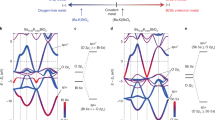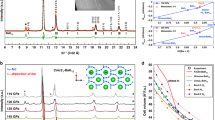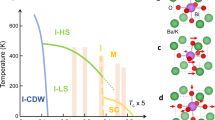Abstract
The recent discovery of superconductivity near 30 K in Ba1−xKxBiO3−y (x≈0.4)1,2 is remarkable for two reasons. It is the first copper-free oxide superconductor that has a transition temperature (Tc) above that for the best intermetallic superconductor; and the structure is reported to be cubic, which excludes a two-dimensional metal–oxygen sublattice analogous to the CuO2 planes believed to be responsible for superconductivity in the copper-oxide-based superconductors. Cava et al.1 described a synthesis technique which involved starting with a 100% excess of KO2. At least part of the excess potassium was found to be present in the final sample (in a form not detectable by X-ray diffraction), resulting in samples that were not suitable for resistivity measurements and making a precise determination of the potassium and oxygen content in the superconducting phase impossible. Here we describe a two-step synthesis technique starting with a stoichiometric oxide composition, which yields single-phase samples suitable for transport measurements. Neutron powder diffraction studies of samples with varying potassium concentration show that superconductivity in Ba1−xKxBiO3−y, occurs only in a cubic perovskite phase which is stable at ≲600°C and which forms only for x > 0.25. Within this cubic phase, Tc is highest for compositions near the structural phase transition (x ≈ 0.25) and decreases with increasing x.
This is a preview of subscription content, access via your institution
Access options
Subscribe to this journal
Receive 51 print issues and online access
$199.00 per year
only $3.90 per issue
Buy this article
- Purchase on Springer Link
- Instant access to full article PDF
Prices may be subject to local taxes which are calculated during checkout
Similar content being viewed by others
References
Cava, R. J. et al. Nature 332, 814–816 (1988).
Mattheiss, L. F., Gyorgy, E. M. & Johnson, D. W. Jr Phys. Rev. B 37, 3745–3746 (1988).
Cox, D. E. & Sleight, A. W. Solid St. Commun. 19, 969–973 (1976).
Schwedes, B. & Hoppe, R. Z. anorg. allg. Chem. 392, 97–106 (1972).
Aurivillius, B. Ark. Kemi Mineral. Geol. 16A, 1–13 (1943).
Cox, D. E. & Sleight, A. W. in Proc. Conf. Neutron Scattering, Gatlinburg, Tennessee, 45–54 (1976).
Suzuki, M. & Murakami, T. Solid St. Commun. 53, 691–694 (1985).
Batlogg, B. Physica B126, 275–279 (1984).
Jorgensen, J. D., Hinks, D. G. & Felcher, G. P. Phys. Rev. B35, 5365–5368 (1987).
Author information
Authors and Affiliations
Rights and permissions
About this article
Cite this article
Hinks, D., Dabrowski, B., Jorgensen, J. et al. Synthesis, structure and superconductivity in the Ba1−xKxBiO3−y system. Nature 333, 836–838 (1988). https://doi.org/10.1038/333836a0
Received:
Accepted:
Issue Date:
DOI: https://doi.org/10.1038/333836a0
This article is cited by
-
An extensive study on multiple ETL and HTL layers to design and simulation of high-performance lead-free CsSnCl3-based perovskite solar cells
Scientific Reports (2023)
-
First-principles analysis of how Cobalt doping affects the structural, electronic, and optical properties of α-MoO3
Indian Journal of Physics (2023)
-
Cesium-mediated electron redistribution and electron-electron interaction in high-pressure metallic CsPbI3
Nature Communications (2022)
-
Hybrid improper ferroelectricity in A-cation ordered perovskite BaSrBi\(_2\)O\(_6\)
Journal of the Korean Physical Society (2022)
-
Cooper-like Pairing and Energy Gap Induced by Ion Electronic Polarizability
Journal of Superconductivity and Novel Magnetism (2017)
Comments
By submitting a comment you agree to abide by our Terms and Community Guidelines. If you find something abusive or that does not comply with our terms or guidelines please flag it as inappropriate.



